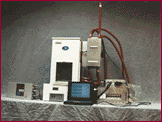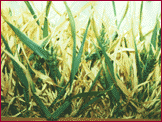



Objectives
Plants can be grown in microgravity and utilized effectively in life support systems. The goal of the Greenhouse investigation is to investigate the effects of microgravity on the productivity of a crop plant, specifically dwarf wheat; to identify the chemical, biochemical, and structural changes in plant tissues induced by microgravity; to determine microgravity's effect on plant processes, such as photosynthesis and water use; and to evaluate current facilities for plant growth aboard the Mir Space Station.
Shuttle-Mir Missions Approach Results
Several potentially important results were found during the Greenhouse experiment. For example, biomass production during the 123-day growth period during far exceeded that of any other comparable experiment with plants in space, which suggests that plant growth is not adversely affected by microgravity. This phenomenon was again indicated in the second planting, which was harvested after 30 days and returned to Earth. The most interesting observation was the lack of seeds in the many wheat heads that were produced; 100% floret sterility was found.
Publications
Salisbury, F. B., G. E. Bingham, W. F. Campbell, J. G. Carman, D. L. Bubenheim, B. Yendler and G. Jahns. 1995. Growing super-dwarf wheat in Svet on Mir. Life Support and Biosphere Science 2:31-39.
Bingham, G. E., S. B. Brown, F. B. Salisbury, W. F. Campbell, J. G. Carman, G. Jahns, D. Pletcher, D. B. Bubenheim, B. Yendler, V. Sytchev, M. A. Levinskikh, I. Podolsky, I. Ivanova, P. Kosgtov and S. Sapunovca. 1996. Environmental measurements observed during the greenhouse-2 experiment on the Mir orbital station. COSPAR 31:364.
Bingham, G., F. Salisbury, W. Campbell, J. Carman, B. Y. Yendler, V. S. Sytchev, Y. B. Berkovich, M. A. Levinskikh and I. Podolsky. 1996. The spacelab-Mir-1 "Greenhouse-2" experiment. Adv. Space Res. 18:225-232.
Salisbury, F. B., W. F. Campbell, J. Carman, G. Bingham, D. L. Bubenheim, B. Yendler, V. Sytchev, M. A. Levinskikh, I. Ivanova, L. Chernova and I. Podolsky. 1996. Plant growth during the greenhouse II experiment on the Mir orbital station. COSPAR 31:364.
Gillespie, L. S., F. B. Salisbury, W. F. Campbell and P. Hole. 1996. Why were Super-Dwarf wheat plants grown in Space Station Mir vegetative: Heat shock, short day, or microgravity? ASGSB Bulletin 10:74.
Salisbury, F. B., G. E. Bingham, W. F. Campbell, J. G. Carman, P. Hole, L. S. Gillespie, V. N. Sytchev, I. B. Podolsky, M. Levinskikh, D. L. Bubenheim and B. Yendler. 1996. Experiments with Super-Dwarf wheat in Space Station Mir. ASGSB Bulletin 10:34.
Salisbury, F. B., G. E. Bingham, W. F. Campbell, J. G. Carman, P. Hole, L. S. Gillespie, R. Nan, L. Jiang, V. N. Sytchev, I. Podolsky, M. Levinskikh, L. Chernova, I. Ivanova, D. L. Bubenheim and B. Yendler. 1996. Growth of Super-Dwarf wheat on the Russian Space Station Mir. 26th Intl. Conf. Environ. Systems, SAE, Monterey, CA. July 8-11.
Principal Investigators
Margarita Levinskikh, Ph.D.![]()
Mir 19, Mir 20, NASA-2, NASA-3
Seed plantings of wheat occurred during the Mir 19 and Mir21/NASA2 missions. Planting was also scheduled to occur during the Mir22/NASA3 mission, but was not performed. Seedling development was monitored by daily observations and photographs taken by the crew. Video was also obtained during the Mir21/NASA2 mission. Plant samples and equipment were returned to Kennedy Space Center (KSC) by the Shuttle, where they were divided among U.S. and Russian investigators for further analysis.
This study greatly advanced the understanding of the nature of the disruption of reproductive events by microgravity. Specifically, researchers have shown that properly designed instrumentation and experiment management can provide the environmental data necessary to document the stresses experienced by the experimental crop. These data can exclude many possible causes of the differences observed between ground and space grown plants. Second, researchers have shown that real-time plant transpiration and gas exchange can be measured. These data, telemetered to Earth on a daily basis, could allow experiment managers to monitor nondestructively (no harvests) the development of plants growing in microgravity on a daily basis. Third, researchers have shown that significant differences exist between the water relations of wet porous substrates in microgravity and on Earth. These differences must be monitored and accounted for to produce healthy plants. Results from the Greenhouse experiments indicate that both the knowledge and instrumentation to provide a good plant root environment in microgravity have been developed.
Bingham, G. E., F. B. Salisbury, W. F. Campbell and J. G. Carman. 1994. The Spacelab-Mir-1 "Greenhouse-2" experiment. Microgravity Science and Technology 18(3):58-65.
Frank B. Salisbury, Ph.D.
Utah State University
Institute of Biomedical Problems
![]()
|
|
Curator:
Julie Oliveaux
Responsible NASA Official: John Uri |
Page last updated: 07/16/1999
.gif)